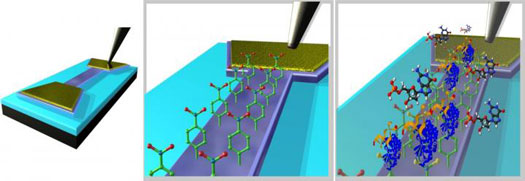| Posted: Sep 19, 2014 |
Graphene sensor tracks down cancer biomarkers
|
|
(Nanowerk News) An ultrasensitive biosensor made from the wonder material graphene has been used to detect molecules that indicate an increased risk of developing cancer.
|
|
The biosensor has been shown to be more than five times more sensitive than bioassay tests currently in use, and was able to provide results in a matter of minutes, opening up the possibility of a rapid, point-of-care diagnostic tool for patients.
|
|
The biosensor has been presented today, 19 September, in IOP Publishing's journal 2D Materials ("Generic epitaxial graphene biosensors for ultrasensitive detection of cancer risk biomarker").
|
 |
| This is an illustration of an epitaxial graphene channel biosensor for detection of targeted 8-hydroxydeoxyguanosine (8-OHdG) biomarker. (A) Schematic of MLEG device (B) Thin film of covalently attached nitro phenyl (PhNO2) groups on the MLEG channel. (C) Attachment of the 'bioreceptor' antibody anti-8-OHdG to the amine terminated MLEG channel and subsequent detection of 8-OHdG.
|
|
To develop a viable bionsensor, the researchers, from the University of Swansea, had to create patterned graphene devices using a large substrate area, which was not possible using the traditional exfoliation technique where layers of graphene are stripped from graphite.
|
|
Instead, they grew graphene onto a silicon carbide substrate under extremely high temperatures and low pressure to form the basis of the biosensor. The researchers then patterned graphene devices, using semiconductor processing techniques, before attaching a number of bioreceptor molecules to the graphene devices. These receptors were able to bind to, or target, a specific molecule present in blood, saliva or urine.
|
|
The molecule, 8-hydroxydeoxyguanosine (8-OHdG), is produced when DNA is damaged and, in elevated levels, has been linked to an increased risk of developing several cancers. However, 8-OHdG is typically present at very low concentrations in urine, so is very difficult to detect using conventional detection assays, known as enzyme-linked immunobsorbant assays (ELISAs).
|
|
In their study, the researchers used x-ray photoelectron spectroscopy and Raman spectroscopy to confirm that the bioreceptor molecules had attached to the graphene biosensor once fabricated, and then exposed the biosensor to a range of concentrations of 8-OHdG.
|
|
When 8-OHdG attached to the bioreceptor molecules on the sensor, there was a notable difference in the graphene channel resistance, which the researchers were able to record.
|
|
Results showed that the graphene sensor was capable of detecting 8-OHdG concentrations as low as 0.1 ng mL-1, which is almost five times more sensitive compared with ELISAs. The graphene biosensor was also considerably faster at detecting the target molecules, completing the analysis in a matter of minutes.
|
|
Moving forward, the researchers highlight the potential of the biosensor to diagnose and monitor a whole range of diseases as it is quite simple to substitute the specific receptor molecules on the graphene surface.
|
|
Co-author of the study Dr Owen Guy said: "Graphene has superb electronic transport properties and has an intrinsically high surface-to-volume ratio, which make it an ideal material for fabricating biosensors.
|
|
Now that we've created the first proof-of-concept biosensor using epitaxial graphene, we will look to investigate a range of different biomarkers associated with different diseases and conditions, as well as detecting a number of different biomarkers on the same chip."
|

